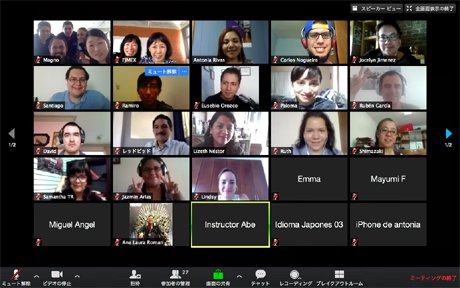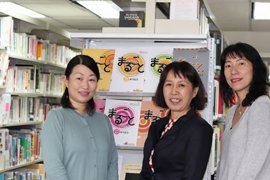A Traveling Japanese-Language Teacher Training Program in Mexico
The Japan Foundation, Mexico
HIRATA Yoshimi, ABE Yasuko, MATSUDA Ryoko
Traveling All Over Mexico?
What do you think of when you hear the words “traveling training program?” Perhaps you imagine instructors traveling all throughout Mexico to host training sessions at a variety of Japanese-language educational institutions to help solve the problems faced by the Japanese-language teachers there. Well, that is precisely the type of training program we wanted to carry out. However, Mexico is a huge country comprised of 32 states that cover roughly five times the area of Japan. Furthermore, our mission is to support not only Japanese teachers in Mexico, but those all throughout Central America and the Caribbean region. In other words, the area we are in charge of is about the same size as the United States. Therefore, it was a considerable challenge, in terms of both personnel and finances, to visit all of the Japanese-language educational institutions that wished to participate in training.
Despite that, our “Traveling Training Program” was realized in 2017. Specifically, we launched a program that uses several of those Japanese-language educational institutions to teach not only the teachers that work there, but also others throughout the country using the Zoom online meeting app.
Connecting Japanese-Language Teachers Throughout the Country
So-called online training generally connects instructors and attendants via the Internet. However, in our Traveling Training Program, we Japanese-Language Specialists actually visit Japanese-language educational institutions to carry out the training. We interact with the participants gathered at the venue directly, while also connecting with those from distant locations participating via the Internet. The training follows a workshop format and includes group work. The Zoom app can handle up to 100 participants and offers a breakout room function that allows those participants to split into various groups of arbitrary size to have discussions with each other. This approach allows those participants unable to come to the venue an opportunity to connect with other Japanese teachers located far away. I truly felt that this Traveling Training Program was worthwhile when I saw those Japanese teachers, who come from different regions and organizations and have different levels of experience and even different native languages, all working on their assigned tasks with their own individual approaches.

Participants of the training
A Team of Three Japanese-Language Specialists
This type of training is also known as "hybrid training" because it combines traditional face-to-face training simultaneously with online training. To be sure, the hurdles are high for the planners and implementers of the training, with the need to consider both direct and online participates, such as projecting PowerPoint presentations in the venue while also showing the material online, and sometimes needing to solve technical problems with the Internet connection mid-training. However, with the enhancement of the Japanese-Language Specialist team at the Japan Foundation, Mexico to three members, we believed that together this was something that the three of us could achieve, and so we decided to implement the Traveling Training Program.

The team of Japanese-Language Specialists
51 Applicants
“The AY2017 Traveling Japanese-Language Teacher Training Program in Mexico” focused on introductory Japanese language teaching for the five-month period of November 2017 to March 2018. A total of 51 people applied. This included applications from Japanese teachers throughout Mexico, from Sinaloa in the north to Quintana Roo in the east. During that time, we traveled to five locations, which were the Japanese Language School of the Mexican Japanese Association, the Society for Asian Studies in Mexico City, Colegio Magno in Guanajuato, Queretaro Language School in Queretaro, and the Japan Foundation, Mexico.
From Mexico to Central America and the Caribbean
When we first started planning the program, we were having trouble deciding whether we should include Japanese teachers throughout Central America and the Caribbean as well. We had many concerns, such as how many people from Mexico would participate, how many schools wanted to serve as venues, and even Internet related technical issues, so we decided to begin by covering only Japanese teachers in Mexico. However, by the time we finished the program in March 2018, we had been able to pass out graduation certificates to 17 participants. Those individuals participated in three or more of the total of five sessions. And five of those participated in every session. There are still many issues to overcome for us as the planners and implementers of the training, but it is apparent that the program served as an invaluable opportunity for Japanese teachers from throughout Mexico to exchange ideas and information, learn about Japanese-language teaching methods, and improve their classes. Accordingly, we will continue this program in AY2018. And this academic year, we will extend the program to include Central America and the Caribbean in addition to Mexico. So we will travel again this year with the hopes of contributing to the further advancement of Japanese-language education so that Japanese teachers from each region can connect with each other.
- What We Do Top
- Arts and Cultural Exchange [Culture]
- Japanese-Language Education Overseas [Language]
- Japanese-Language Education Overseas [Language] Top
- Learn Japanese-language
- Teach Japanese-language
- Take Japanese-Language Test
- Know about Japanese-language education abroad
- The Japanese-Language Institute, Urawa
- The Japanese-Language Institute, Kansai
- Japanese-Language Programs for Foreign Specified Skilled Worker Candidates
- Japanese Language Education for Japanese Children Resident Overseas and for the Descendants of Migrants
- Archives
- Japanese Studies and Global Partnerships [Dialogue]
- JF digital collection
- Other Programs / Programs to Commemorate Exchange Year
- Awards and Prizes
- Publications
